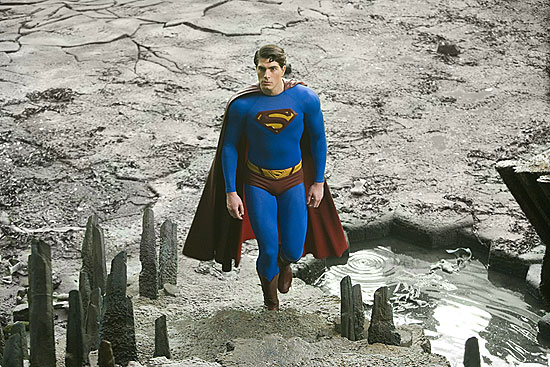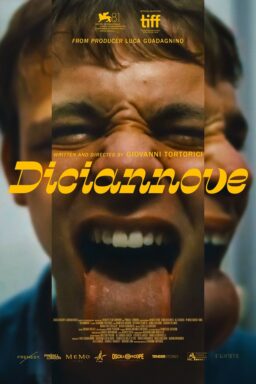Superheroes may have been born in comic books, but they were made for the movies. Defying the laws of physics, and occasionally the laws of society, they tend to be transgressors whose supernatural powers (or costumes and gadgets) enable them to surpass the abilities of mortals when it comes to maintaining stability and order — or, at least, exacting revenge — whether they act on behalf of themselves or society (or the cosmos) at large. “Truth, justice and the American Way,” as the Man of Steel might put it.
Sometimes, too, they are conflicted. They can’t just deny their gifts and live ordinary lives (see “The Last Temptation of Christ“), much as they may yearn to. As Peter Parker learns, with great power comes great responsibility. But their gifts may also be a curse, their super-powers and personae having resulted from some great personal tragedy or accident — the death of parents or the destruction of a planet, or even both. A birth myth is indispensable in such cases.
So, it’s not just about the “skills,” in non-superhero Napoleon Dynamite’s term. Superheroes may be driven by deep psychological wounds that will never quite heal. And sometimes capes and tights are the only dressing that works.
Because their identities must be concealed, and they can only fly free and express themselves fully while in costume, it’s no wonder superheroes are often seen as metaphors for closeted gays in a hostile world. (Yes, this was part of the mythos long before “Superman Returns.”) And superheroes tend to discover, and learn to master and control, the full extent of their powers in adolescence, along with their sexuality. (Think of the Midwestern section of Richard Donner’s “Superman,” with young Clark Kent learning self-discipline on the farm, and the high school football field.)
Below, Roger Ebert traces the development of the movie superhero from the birth of the modern era in 1978 to 2006’s “Superman Returns.” — JE
“Superman” (1978)
Superman is a pure delight, a wondrous combination of all the old-fashioned things we never really get tired of: adventure and romance, heroes and villains, earthshaking special effects, and — you know what else? Wit. That surprised me more than anything: That this big-budget epic, which was half a decade making its way to the screen, would turn out to have an intelligent sense of humor about itself.
“Superman II” (1980)
From his earliest days in a comic book, Superman always has been an urban hero. He lived in a universe that was defined by screaming banner headlines and vast symbolic acts, and “Superman II” catches that flavor perfectly with its use of famous landmarks like the Eiffel Tower, the Empire State Building, Niagara Falls, and the Coca-Cola sign in Times Square. He was a pop hero in a pop world, and like Mickey Mouse and the original Coke trademark, he became an instantly recognizable trademark.
“Flash Gordon” (1980)
This new Dino De Laurentiis production is true to the tacky pop origins of the Flash Gordon comic strip and the serials starring Buster Crabbe. At a time when “Star Wars” and its spin-offs have inspired special effects men to bust a gut making their interplanetary adventures look real, “Flash Gordon” is cheerfully willing to look as phony as it is. I don’t mean that as a criticism. You can make a city float in the clouds and look marginally realistic (as in “The Empire Strikes Back“), but there’s something sort of fun about the “Flash Gordon” city that floats in the clouds and looks like a large miniature model floating in fake clouds. And as the spaceships lumber past on the screen, I really wouldn’t have minded if they’d left a tube of model airplane glue lying in the lower left-hand corner.
“Supergirl” (1984)
The best way to approach “Supergirl” is through a statement by Clint Eastwood, who once observed that his spaghetti Westerns worked only because he played them completely seriously. In the famous scene where he shoots three guys with one bullet, if the faintest wisp of a smile had creased his lips, the whole power of the scene would have been destroyed. Only by playing it straight did he make the scene work — and it worked, incidentally, as comedy. “Supergirl” doesn’t know that.
“Batman” (1989)
The Gotham City created in “Batman” is one of the most distinctive and atmospheric places I’ve seen in the movies. It’s a shame something more memorable doesn’t happen there. “Batman” is a triumph of design over story, style over substance — a great-looking movie with a plot you can’t care much about…. “Batman” discards the recent cultural history of the Batman character — the camp 1960s TV series, the in-joke comic books — and returns to the mood of the 1940s, the decade of film noir and fascism.
“Batman Returns” (1992)
The gloomy undertone of the Batman movies is like a tow line, holding the movie back, keeping it from springing free into the wind. Tim Burton’s “Batman Returns,” even more than the original “Batman,” is a dark, brooding film, filled with hurt and fear, childhood wounds and festering adult resentments. It is also a most intriguing movie, great to look at, fun to talk about. There is no doubt Burton is a gifted director, but is he the right director for Batman?
“The Crow” (1994)
The visual style, by cinematographer Dariusz Wolski, obviously owes a great deal to the study of comic books (or “graphic novels,” as they like to be called). The camera swoops high above the city, or dips low for extreme-angle shots. Shadows cast fearsome daggers into the light. Buildings are exaggerated in their architectural details, until they seem a shriek of ornamentation. The superhero comic books of the 1940s, especially “Batman,” grew up at the same time as film noir, and borrowed some of the same visual language. But comic books were not simply drawn versions of film noir; for one thing, the films tended to use their extreme-angle shots for atmosphere and storytelling, and would hold them for a time, while comics are meant to be read quickly, and give the equivalent of cinematic quick-cutting. “The Crow,” with its fast pace and its countless camera set-ups, evokes comics much more than the more good-looking but more leisurely “Batman” movies.
It also reflects a bleak modern sensibility, with little room for the comic villians in “Batman.” The actors are adapted in appearance to this graphic noir vision; their appearances are as exaggerated as the shots they appear in. For example: The bosoms of women in comic books always seem improbably perfect but sketched in — drawn by a pen, not made of flesh — and the villainess Myca (Bai Ling) in this story has the same look. As the half-sister of the villain, she represents a drawn image, not a person, and so do many of the other characters, including a thin, angular Brandon Lee behind his makeup.
“Batman Forever” (1995)
A question has been nagging at me ever since the first Batman movie, and “Batman Forever” makes it inescapable: Would Bruce Wayne continue his keen interest in crime fighting if he didn’t get to wear the Batman costume? The opening scene plays like a commercial for a rubberwear shop, and throughout the movie, the dominant images are of fetishistic gear: The belt buckles, boots, gloves, capes, masks, and of course, the cute little dime-sized nipples on Batman’s and Robin’s chests. When Batman tries on his new prototype costume late in the movie, and there’s a closeup of its gleaming buttocks, the audience chuckles knowingly.
“Spawn” (1997)
“Spawn” is best seen as an experimental art film…. Spawn himself is an extraordinary superhero, with smoking green eyeballs and two looks — scarred skin, or a uniform that makes Batman look underdressed. Clown is a shape-shifter who can impersonate almost anyone else in the movie; Leguizamo’s features are buried in fat makeup and then transplanted by animation onto a grotesque clown’s body. There is a dragonlike thing, the beast of hell, that is all tooth and eyeball and disgusting coiling tongue (an “overgrown gekko,” it’s called). And there are vast vistas of the expanse of hell, with countless souls writhing on clouds of flame, tortured by the very anonymity of their suffering. Against this, and preventing the film from being even better, is a pretty sappy plot.
“Batman and Robin” (1997)
Watching it, I realized why it makes absolutely no difference who plays Batman: There’s nobody at home. The character is the ultimate Suit. Garb him in leather or rubber, and he’s an action hero — Buzz Lightyear with a heartbeat. Put him in civilian clothes, and he’s a nowhere man.
I’ve always suspected they cast movie Batmans by their chins, which is all you see when the Bat costume is being worn, and Clooney has the best chin yet. But like Michael Keaton and Val Kilmer, he brings nothing much to the role because there’s nothing much there. Most of the time he seems stuck for conversation. I think the way to get him started would be to ask about his technological gimmicks. This is a guy who would rather read the Sharper Image catalog than Playboy.
“Orgazmo” (1998)
Elder Young is given the role of Orgazmo, a porno superhero with a sidekick named Choda-Boy (Dian Bachar). They crash through cardboard walls to rescue damsels in distress (or damsels being ravished by Ron Jeremy, which amounts to the same thing). His weapon (Orgazmo’s) is an Orgazmorator, which immobilizes his enemies with multiple orgasms. In a movie with wit, people would be lining up to become Orgazmo’s enemies.
…. “South Park” is elegant, in its way: A self-contained animated universe that functions as a laboratory to conduct experiments in affronting the values of viewers, who, if they held them, would not be watching. I like “South Park.” It has wit. I guess “Orgazmo” was a stage the boys had to go through. They’re juniors now.
“Blade” (1998)
Wesley Snipes understands the material from the inside out and makes an effective Blade because he knows that the key ingredient in any interesting superhero is not omnipotence, but vulnerability. There is always a kind of sadness underlying the personalities of the great superheroes, who have been given great knowledge and gifts but few consolations in their battle against evil. The fun all seems to be on the villain’s side. By embodying those feelings, Snipes as Blade gives the movie that edge of emotion without which it would simply be special effects. Of course you have to bring something to it yourself, preferably a sympathy for the whole comic superhero ethos. This is the kind of movie that gets better the more you know about the genre.
“Mystery Men” (1999)
The B team includes The Blue Raja (Hank Azaria), who hurls forks and spoons with amazing strength; Mr. Furious (Ben Stiller), who gets bad when he gets mad, and The Shoveler (William H. Macy), whowhacks people with a spade. They’re joined by new hopefuls, including The Spleen (Paul Reubens), whose weapon is voluminous flatulence; the Bowler (Janeane Garofolo), whose father’s skull is inside her transparent bowling ball; Invisible Boy (Kel Mitchell), whose invisibility has to be taken mostly on trust, since you can’t see if he’s really there; and The Sphinx (Wes Studi), whose sayings make the Psychic Friends Network look deep.
“X-Men” (2000)
The origin story is crucial to all superhero epics, from the gods of ancient Greece right down to Superman’s parents. Next in importance is an explanation of superpowers: what they are, how they work. That’s reasonable when there is one superhero, like Superman or the Crow, but in “X-Men,” with eight major characters and more in supporting roles, the movie gets top-heavy. At the halfway mark, it has just about finished introducing the characters.
“Blade II” (2002)
“Blade II” is a really rather brilliant vomitorium of viscera, a comic book with dreams of becoming a textbook for mad surgeons. There are shots here of the insides of vampires that make your average autopsy look like a slow afternoon at Supercuts. The movie has been directed by Guillermo del Toro, whose work is dominated by two obsessions: War between implacable ancient enemies, and sickening things that bite you and aren’t even designed to let go.
“Spider-Man” (2002)
Imagine “Superman” with a Clark Kent more charismatic than the Man of Steel, and you’ll understand how “Spider-Man” goes wrong. Tobey Maguire is pitch-perfect as the socially retarded Peter Parker, but when he becomes Spider-Man, the film turns to action sequences that zip along like perfunctory cartoons. Not even during Spidey’s first experimental outings do we feel that flesh and blood are contending with gravity. Spidey soars too quickly through the skies of Manhattan; he’s as convincing as Mighty Mouse.
“X2: X-Men United” (2003)
Like all the characters in the Marvel Comics stable, the X-Men have psychological or political problems; in the first movie they were faced with genocide, and in this one their right to privacy is violated with the Mutant Registration Act. Of course there will be audience members who believe mutants should have no rights, and so “X2” provides a valuable civics lesson. (How you register a mutant who can teleport or shape-shift is not explained.) Perhaps not coincidentally, the movie has a president who looks remarkably like George W. Bush. The film opens with one of its best scenes, as a creature with a forked tail attacks the White House and whooshes down corridors and careens off walls while the Secret Service fires blindly. The creature’s purpose is apparently to give mutants a bad name, inspiring still more laws undermining their rights.
“Daredevil” (2003)
The origin is usually similar: A traumatic event in childhood, often involving the loss of parents, leaves the future superhero scarred in some ways but with preternatural powers in others. “Daredevil” came out of the Marvel Comics stable in the same period as “Spider-Man” and both were altered by accidents, which gave Peter Parker his spidey-sense, and blinded Matt Murdock but made his other four senses hypersensitive. They grew up together in Marvel comics, sometimes sharing the same adventures, but you won’t see them fraternizing in the movies because their rights are owned by different studios.
“Hulk” (2003)
The Hulk is rare among Marvel superheroes in that his powers are a curse, not an advantage. When rage overcomes Dr. Bruce Banner and he turns into a green monster many times his original size, it is not to fight evil or defend the American way, but simply to lash out at his tormentors. Like the Frankenstein stories that are its predecessors, “Hulk” is a warning about the folly of those who would toy with the secrets of life. It is about the anguish of having powers you did not seek and do not desire….
Whether “Hulk” will appeal to its primary audience–teenage science fiction fans–is hard to say. No doubt it will set the usual box office records over the weekend, but will it reach audiences who will respond to its dramatic ambition? Ang Lee has boldly taken the broad outlines of a comic book story and transformed them to his own purposes; this is a comic book movie for people who wouldn’t be caught dead at a comic book movie.
“Spider-Man 2” (2004)
Now this is what a superhero movie should be. “Spider-Man 2” believes in its story in the same way serious comic readers believe, when the adventures on the page express their own dreams and wishes. It’s not camp and it’s not nostalgia, it’s not wall-to-wall special effects and it’s not pickled in angst. It’s simply and poignantly a realization that being Spider-Man is a burden that Peter Parker is not entirely willing to bear.
The movie demonstrates what’s wrong with a lot of other superhero epics: They focus on the superpowers, and short-change the humans behind them. (Has anyone ever been more boring, for instance, than Clark Kent or Bruce Wayne?) “Spider-Man 2” is the best superhero movie since the modern genre was launched with “Superman” (1978). It succeeds by being true to the insight that allowed Marvel Comics to upturn decades of comic-book tradition: Readers could identify more completely with heroes like themselves than with remote godlike paragons.
“Catwoman” (2004)
She gobbles down tuna and sushi. Her eyes have vertical pupils instead of round ones. She sleeps on a shelf. The movie doesn’t get into the litter box situation. What does she think about all of this? Why isn’t she more astonished that it has happened to her? How does it affect her relationship with that cute cop, Tom Lone (Benjamin Bratt)? The movie makes it clear that they make love at least once, but we don’t see that happening because “Catwoman,” a film that was born to be rated R, has been squeezed into the PG-13 category to rake in every last teenage dollar. From what we know about Catwoman, her style in bed has probably changed along with everything else, and sure enough, the next day he notices a claw mark on his shoulder. Given the MPAA’s preference for violence over sex, this might have been one sex scene that could have sneaked in under the PG-13.
“Hellboy” (2004)
Hellboy’s life is a lonely one. When you are 7 feet tall and bright red with a tail, you don’t exactly fit in, even though HB tries to make himself look more normal by sawing his horns down to stumps, which he sands every morning. He is in love with another paranormal, Liz Sherman (Selma Blair), a pyrokineticist who feels guilty because she starts fires when she gets excited. There is a terrific scene where Hellboy kisses her and she bursts into flames, and we realize they were made for each other because Hellboy, of course, is fireproof.
“Batman Begins” (2005)
This is at last the Batman movie I’ve been waiting for. The character resonates more deeply with me than the other comic superheroes, perhaps because when I discovered him as a child, he seemed darker and more grown-up than the cheerful Superman. He has secrets. As Alfred muses: “Strange injuries and a nonexistent social life. These things beg the question, what does Bruce Wayne do with his time?”
“Elektra” (2005)
“Elektra” plays like a collision between leftover bits and pieces of Marvel superhero stories. It can’t decide what tone to strike. It goes for satire by giving its heroine an agent who suggests mutual funds for her murder-for-hire fees, and sends her a fruit basket before her next killing. And then it goes for melancholy by making Elektra a lonely, unfulfilled overachiever who was bullied as a child and suffers from obsessive-compulsive disorder. It goes for cheap sentiment by having her bond with a 12-year-old girl, and then … but see for yourself. The movie’s a muddle in search of a rationale.
“Fantastic Four” (2005)
But after Johnny Storm finds out he has become the Human Torch, he takes it pretty much in stride, showing off a little by setting his thumb on fire. Later he saves the Earth, while Invisible Woman simultaneously contains his supernova so he doesn’t destroy it. That means Invisible Woman could maybe create a force field to contain the sun, which would be a big deal, but she’s too distracted to explore the possibilities; she gets uptight because she will have to be naked to be invisible, because otherwise people could see her empty clothes; it is no consolation to her that invisible nudity is more of a metaphysical concept than a condition.
Are these people complete idiots? The entire nature of their existence has radically changed, and they’re about as excited as if they got a makeover on “Oprah.” The exception is Ben Grimm, as the Thing, who gets depressed when he looks in the mirror. Unlike the others, who look normal except when actually exhibiting superpowers, he looks like – well, he looks like his suits would fit The Hulk, just as the Human Torch looks like The Flash, and the Invisible Woman reminds me of Storm in “X-Men.”
“X-Men: The Last Stand” (2006)
There are so many parallels here with current political and social issues that to list them is to define the next presidential campaign. Just writing the previous paragraph, I thought of abortion, gun control, stem cell research, the “gay gene” and the Minutemen. “Curing” mutants is obviously a form of genetic engineering and stirs thoughts of “cures” for many other conditions humans are born with, which could be loosely defined as anything that prevents you from being just like George or Georgette Clooney. The fact is, most people grow accustomed to the hands they’ve been dealt and rather resent the opportunity to become “normal.” (Normal in this context is whatever makes you more like them and less like yourself.)












